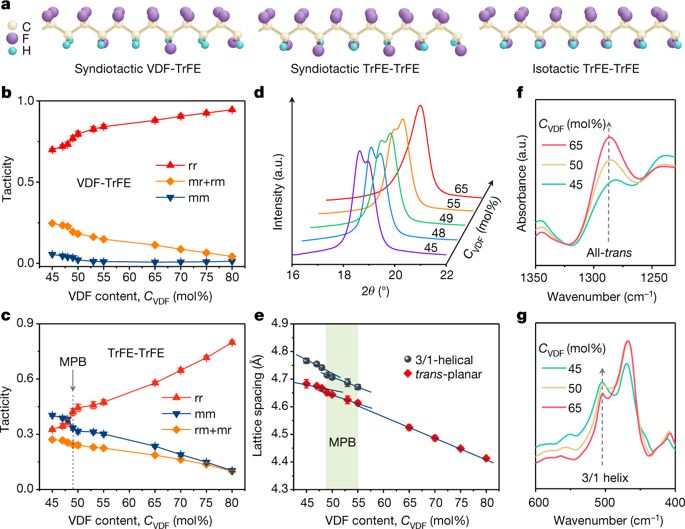Our official English website, www.x-mol.net, welcomes your
feedback! (Note: you will need to create a separate account there.)
Ferroelectric polymers exhibiting behaviour reminiscent of a morphotropic phase boundary
Nature ( IF 50.5 ) Pub Date : 2018-10-01 , DOI: 10.1038/s41586-018-0550-z Yang Liu , Haibibu Aziguli , Bing Zhang , Wenhan Xu , Wenchang Lu , J. Bernholc , Qing Wang
Nature ( IF 50.5 ) Pub Date : 2018-10-01 , DOI: 10.1038/s41586-018-0550-z Yang Liu , Haibibu Aziguli , Bing Zhang , Wenhan Xu , Wenchang Lu , J. Bernholc , Qing Wang

|
Piezoelectricity—the direct interconversion between mechanical and electrical energies—is usually remarkably enhanced at the morphotropic phase boundary of ferroelectric materials1–4, which marks a transition region in the phase diagram of piezoelectric materials and bridges two competing phases with distinct symmetries1,5. Such enhancement has enabled the recent development of various lead and lead-free piezoelectric perovskites with outstanding piezoelectric properties for use in actuators, transducers, sensors and energy-harvesting applications5–8. However, the morphotropic phase boundary has never been observed in organic materials, and the absence of effective approaches to improving the intrinsic piezoelectric responses of polymers9,10 considerably hampers their application to flexible, wearable and biocompatible devices. Here we report stereochemically induced behaviour in ferroelectric poly(vinylidene fluoride-co-trifluoroethylene) (P(VDF-TrFE)) copolymers, which is similar to that observed at morphotropic phase boundaries in perovskites. We reveal that compositionally tailored tacticity (the stereochemical arrangement of chiral centres related to the TrFE monomers11,12) can lead to intramolecular order-to-disorder evolution in the crystalline phase and thus to an intermediate transition region that is reminiscent of the morphotropic phase boundary, where competing ferroelectric and relaxor properties appear simultaneously. Our first-principles calculations confirm the crucial role of chain tacticity in driving the formation of this transition region via structural competition between the trans-planar and 3/1-helical phases. We show that the P(VDF-TrFE) copolymer with the morphotropic composition exhibits a longitudinal piezoelectric coefficient of −63.5 picocoulombs per newton, outperforming state-of-the-art piezoelectric polymers10. Given the flexibility in the molecular design and synthesis of organic ferroelectric materials, this work opens up the way for the development of scalable, high-performance piezoelectric polymers.An organic copolymer with compositionally tailored tacticity exhibits behaviour reminiscent of a morphotropic phase boundary, with an intramolecular order-to-disorder transition in the crystalline phase and a very large piezoelectric coefficient.
中文翻译:

铁电聚合物表现出的行为让人想起同形相界
压电性——机械能和电能之间的直接相互转换——通常在铁电材料的同向相界 1-4 处显着增强,这标志着压电材料相图中的过渡区域,并桥接了两个具有不同对称性的竞争相 1,5。这种增强使各种铅和无铅压电钙钛矿的最新发展成为可能,这些钙钛矿具有出色的压电性能,可用于执行器、换能器、传感器和能量收集应用 5-8。然而,在有机材料中从未观察到同向相界,并且缺乏改善聚合物固有压电响应的有效方法 9,10 大大阻碍了它们在柔性、可穿戴和生物相容性设备中的应用。在这里,我们报告了铁电聚(偏二氟乙烯-三氟乙烯)(P(VDF-TrFE))共聚物的立体化学诱导行为,这类似于在钙钛矿的同向相边界处观察到的行为。我们揭示了成分定制的规整度(与 TrFE 单体相关的手性中心的立体化学排列 11,12)可以导致结晶相中分子内有序到无序的演变,从而导致中间过渡区域,这让人联想到同形相界,其中竞争的铁电和弛豫特性同时出现。我们的第一性原理计算证实了链规整性在通过跨平面相和 3/1 螺旋相之间的结构竞争驱动该过渡区形成中的关键作用。我们表明,具有同向成分的 P(VDF-TrFE) 共聚物的纵向压电系数为 -63.5 皮库仑/牛顿,优于最先进的压电聚合物 10。鉴于有机铁电材料分子设计和合成的灵活性,这项工作为开发可扩展的高性能压电聚合物开辟了道路。结晶相中的分子内有序到无序转变和非常大的压电系数。
更新日期:2018-10-01
中文翻译:

铁电聚合物表现出的行为让人想起同形相界
压电性——机械能和电能之间的直接相互转换——通常在铁电材料的同向相界 1-4 处显着增强,这标志着压电材料相图中的过渡区域,并桥接了两个具有不同对称性的竞争相 1,5。这种增强使各种铅和无铅压电钙钛矿的最新发展成为可能,这些钙钛矿具有出色的压电性能,可用于执行器、换能器、传感器和能量收集应用 5-8。然而,在有机材料中从未观察到同向相界,并且缺乏改善聚合物固有压电响应的有效方法 9,10 大大阻碍了它们在柔性、可穿戴和生物相容性设备中的应用。在这里,我们报告了铁电聚(偏二氟乙烯-三氟乙烯)(P(VDF-TrFE))共聚物的立体化学诱导行为,这类似于在钙钛矿的同向相边界处观察到的行为。我们揭示了成分定制的规整度(与 TrFE 单体相关的手性中心的立体化学排列 11,12)可以导致结晶相中分子内有序到无序的演变,从而导致中间过渡区域,这让人联想到同形相界,其中竞争的铁电和弛豫特性同时出现。我们的第一性原理计算证实了链规整性在通过跨平面相和 3/1 螺旋相之间的结构竞争驱动该过渡区形成中的关键作用。我们表明,具有同向成分的 P(VDF-TrFE) 共聚物的纵向压电系数为 -63.5 皮库仑/牛顿,优于最先进的压电聚合物 10。鉴于有机铁电材料分子设计和合成的灵活性,这项工作为开发可扩展的高性能压电聚合物开辟了道路。结晶相中的分子内有序到无序转变和非常大的压电系数。











































 京公网安备 11010802027423号
京公网安备 11010802027423号